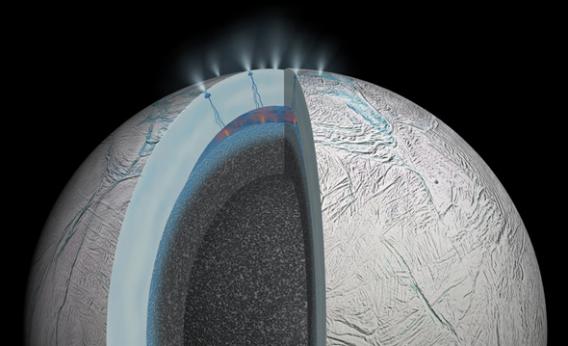Create a free profile to get unlimited access to exclusive videos, sweepstakes, and more!
Evidence for Hydrothermal Vents on Saturn’s Moon Enceladus Hints at
Conditions for Life

When we think about life in the solar system, we tend to look to Mars. But science has broadened our minds in recent times—science has a way of doing that—and many scientists are turning their attention to the outer solar system. There are moons made of ice there, and some have entire oceans of liquid water under their surfaces.
Saturn’s moon Enceladus is particularly interesting, with geysers of water spewing hundreds of kilometers into space from its south pole. And now it’s just gotten even more exciting: Two teams of scientists have found evidence of hydrothermal vent activity on the little moon!
We know there’s liquid water under the surface of Enceladus because of the geysers. The mighty gravity of Saturn squeezes and stresses the moon, and friction inside it heats it, causing the ice to melt. Cracks near the south pole (called sulci, singular: sulcus, a word I’m fond of) open and close as the moon is squeezed, and the huge pressure under the surface causes the water to erupt out.
These geysers were discovered in Cassini spacecraft images. The probe actually flew through a plume and detected water, dust, and simple organic molecules, too.
But this is different than hydrothermal activity. The evidence comes in the form of teeny tiny bits of silicate material detected by Cassini as well. This stuff is in the volume of space around Saturn, and it consists of grains only a few nanometers across (a typical bacterium is 10x bigger for comparison). The most likely source of these grains is hydrothermal vents in Enceladus; hot water with dissolved minerals in it comes into contact with colder water, and the minerals precipitate out in the colder environment, forming the grains. These then are carried out and blasted into space by the geysers.
This fits well with what we know of Enceladus; the surface is frozen, there’s an ocean of water underneath, and then under that is probably a rocky core of material. That last would be the source of the minerals. The core itself is probably warmed by the same tidal friction from Saturn keeping the water liquid above it. Cracks form in the core/water boundary where hot material can come out: hydrothermal vents.
The second team of scientists were looking for the source of methane that’s been found in the plumes. These same hydrothermal vents are one likely source, bringing methane-laden compounds into Enceladus’ undersurface ocean, which again then spews them out in the geysers. They note it’s possible there is another, nonhydrothermal source, but given the other study finding silica, the idea of hot vents makes sense. It’s possible both ways are at work as well; but if true, that still means the hydrothermal vents are there.
So what’s the big deal? Well, understanding how geologic processes work on other worlds is exceedingly cool. But there’s a more immediate interest in this as well.
We see these vents in the ocean bottom on Earth, too. The water there is very hot, heated by tectonic processes inside Earth’s crust. It brings up minerals and nutrients, and life thrives there. A lot of the processes are the same as what’s imagined is happening on Enceladus; minerals are dissolved in hot water that spews up into the cold ocean, precipitating out. A lot of it is sulfur-based, but amazingly life exists there anyway. The environment is highly toxic to humans—huge pressure, boiling water near the vents, freezing a bit farther away, and loaded with icky chemicals—but as a scientist once said, “Life finds a way.”*
Are there giant alien tube worms filtering the waters of Enceladus for life-giving nutrients a billion kilometers from Earth? It’s a nice thought, and it’s possible. I wouldn’t say it’s likely just yet; we’re a long way from that. But this evidence for hydrothermal vents takes us a nice step closer to knowing. And that is a very exciting step indeed.
*Yes, I mean Ian Malcolm from Jurassic Park, and yes he was a terrible scientist who didn’t understand chaos theory at all, but it’s still a good line.


























